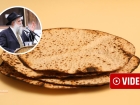Shemos: Building a Dwelling For Hashem Brick By Brick
From the desk of Rabbi Nissim Lagziel, Mashpia in Oholei Torah: Our parsha, Shemos, begins a new book of the Torah. At the beginning of the parsha, we are told about the tremendous growth of the Jewish people in Egypt, and about the Egyptians’ fear that the Jews woud overtake them • Full Article
BEGIN WITH A GRIN
Every senior is rich in natural resources. He has gold in his teeth, stones in his kidneys, sugar in his blood, iron in his arteries, platinum in his joints, and an abundance of sodium in his body…
BRICK-AND-MORTAR BUSINESS
Our parsha, Shemos, begins a new book of the Torah. At the beginning of the parsha, we are told about the tremendous growth of the Jewish people in Egypt, and about the Egyptians’ fear that the Jews woud overtake them. The wicked Pharaoh manages to turn the Jews into slaves and they suffer in Egypt from difficult forced labor, making bricks and building cities.
The Torah focuses on a description of the type of labor the Egyptians forced them to do, which seems unimportant. “And they embittered their lives with hard work with clay and bricks and all sorts of work in the field, all the work which they worked with them with back-breaking labor.” The first type of work described in the verse is, “clay and bricks,” and this labor is what brought with it all the other work, later on. As the Gemara (Sota 11b) says, “Rava says: At first with clay and bricks and ultimately all sorts of work in the field, all the work.”
Even the hardship of servitude that followed is very much connected with … bricks! What was Pharaoh upset about? What caused him to make the Jews work even harder? The fact that they did not make enough bricks! Why was it so important for the Torah to tell us about bricks? Since when has the Torah turned into a DIY construction manual and most importantly, what can we learn from this on the eve of the true and complete Geula?
We all know the famous Medrash (Tanchuma Naso 16): G-d desired to have a dwelling in the lower realm. In Chassidus, we find extensive explanations to this Medrash but simply put, the Medrash says the purpose of the creation of the world is so that there will be a reality of lower realms, worlds in which G-d is not revealed, to the extent that it will be possible to say, G-d forbid, that He does not exist. It is in these lower realms specifically in which the highest G-dly spiritual level will be revealed; as Chassidus calls it, “the aspect of Atzmus Ein Sof.”
How can mortal man “draw down” these highest levels of G-dliness? With the power of Torah and mitzvos. Through fulfilling Torah and mitzvos, with every mitzva that a Jew does, he adds a “stone” or “brick” to G-d’s dwelling, preparing the world as a dwelling for Him.
This new perspective will also lead us in the direction of the answer we seek about the start of the servitude in Egypt and the use of “clay and bricks.” The holy Zohar says that kelipa is like “a monkey before man,” i.e. kelipa and impurity imitates holiness and mimics it, just as a monkey copies a person’s movements that he sees. That is why, just as in holiness, the main thing in the service of G-d, the purpose for which the world was created is the “avoda of building” – making a dwelling for G-d in the lower realms, so too, in kelipa, the main [opposition to holiness through imposing] hardship and servitude was expressed in constructing huge cities for Pharaoh in Egypt.
But why clay and bricks? Why not stones used in construction? Why shouldn’t the Jewish people work additional hours quarrying stone or maybe even marble?
BRICK VS STONE
In Chassidus (Torah Ohr, Mishpatim) there is a deep explanation about the difference between stones and bricks. Stone is chiseled out of a mountain; it is found in nature, made by G-d. Man just needs to quarry it and then shape it to his needs. Bricks, on the other hand, are man-made. You take earth and water, put it in an oven and you get a brick.
In holiness too, there is this difference between stones (made by G-d), alluding to a higher level than bricks (man-made). In the language of Kabbala and Chassidus, stone represents an ‘arousal from Above’ (a higher power) while bricks represent an ‘arousal from below’ (personal inspiration that comes from down here).
In order to achieve the goal of creation, a dwelling down below, we need ‘bricks’ – self-driven work that comes from the inhabitants of the lowly realm. The ‘dwelling’ can’t be built with ‘stones’ – spiritually inspired from Above.
If G-d initially created the world in a way that the G-dly light shone in an open and revealed manner, there would never be “lower realms,” there would be nothing that opposed G-d, not even as an illusion.
Specifically when creation is constructed in a way of obfuscation, when darkness was created, a state which conceals G-dliness, and within that darkness there exists a Jew, a lofty soul within a physical body, who fulfills Torah and mitzvos, that transforms the darkness into light. Consequently, G-d’s holiness penetrates even places of darkness, places of impurity and kelipa, and elevates them together with the entire world to G-dliness. This is how a dwelling is made in the lower realms!
The Egyptians wanted for themselves what holiness wants for itself, and just as the main goal of the creation of the world is not a revelation of G-dliness from above, something comparable to stone, but the work of Jews here below, comparable to bricks, so too, the main servitude in Egypt was with bricks; using them to build big cities for the evil Pharaoh.
A dwelling below can only be built through work, effort, blood, sweat and tears, and not by thinking that I can just stand off to the side and wait for someone else to do the work instead of me, or that G-d will send an angel to straighten things out. This is the important message which the Torah wants to teach us by focusing on the ‘clay and bricks.’ This is the reason why the Egyptian exile began with ‘clay and bricks,’ because it was with bricks that we entered exile and with bricks that we will get out of exile!
TO CONCLUDE WITH A STORY
We will end with a story/parable which emphasizes this very point (as told by Uncle Yossi in The Three Sacks of Gold) a king who called four celebrated artists and told each of them to paint a giant painting on one of the walls of the room. The king said each artist would be given 1500 rubles for his painting and the artist who made the nicest picture would get a bonus of 250 rubles. The condition was the painting had to be ready in a month.
Three artists got to work immediately and within a few days one could see the beginnings of their work. One painted the king riding a mighty horse, another worked on a breathtaking vista, while the third painted the main street of the kingdom. As for the fourth wall, nothing. It remained empty.
The appointed day arrived and the artists each stood at their wall. The king entered. Three walls were decorated by the artists’ work while the fourth wall was covered with a sheet.
After each artist explained his painting, the king turned to the fourth artist. The artist removed the sheet and before everyone’s astonished eyes there appeared a huge mirror in which they could see a reflection of the painting on the opposite wall.
The king called for his servant and told him to place a chest of money next to three of the walls. “What about me?” asked the fourth artist.
“See,” said the king, “there is your chest, a reflection of the artist’s chest opposite you.”
Good Shabbos!
42
Join ChabadInfo's News Roundup and alerts for the HOTTEST Chabad news and updates!









































